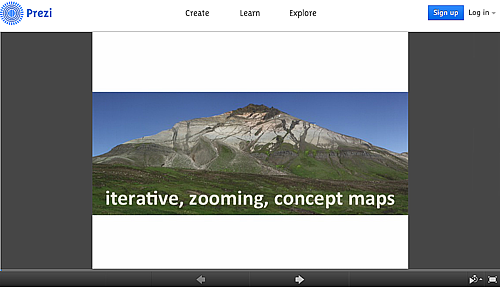Presentation and Pedagogical Modes: From PowerPoint to Prezi
Saturday, September 29, 2012
1:30-3:00 PM, WCC 230
Pecha Kucha Transforms Power Point into Visual Pedagogy Technology for the 21st Century
Robert Smythe, Adjunct Instructor, Temple University
In my Theatre History course, I successfully use a relatively low-tech approach in designing visual assignments that transforms my students from indifferent note-takers into engaged scholars who demonstrate a multi-layered understanding of ideas. This all happens with just a digital projector and good ol’ PowerPoint, as students conduct self-directed research and communicate their findings in a form of presentation known as pecha kucha, Japanese for “chit chat.”
In a pecha kucha, the presenter talks while each of 20 visual images advances every 20 seconds. There are no gaps between talks, and all discussion is saved until the end. These concise presentations—each takes six minutes and 40 seconds—establish a rapid pace that reveals unexpected ideas as speakers and audiences make connections between images.
The recipient of Guggenheim, Pew, NEA and six Pennsylvania Council on the Arts fellowships, and named “Best Professor” by Philadelphia Magazine, Robert Smythe is an acclaimed theater artist turned academic. Credited with “sparking Philadelphia’s theatrical renaissance that continues today,” his varied interests have led to winning six Barrymore Awards for Excellence in Theater in areas ranging from education to choreography. A research-loving MFA, his work on motor contagion has been published in Acta Psychologica; his ground-breaking application of narrative theory to puppetry appeared in Puppetry International. He is currently the Director of Emerging Artists for the International Puppetry Conference at the Tony Award-winning Eugene O’Neill Theater Center.
Synthesizing multi-scale geologic concepts by creating iterative, zooming, concept maps with Prezi
Tamara Carley, Graduate Student, Vanderbilt University
Iterative, Zooming, Concept Maps Prezi
Geology, like many scientific disciplines, requires learners to explore and understand processes operating on, and features expressed at, dramatically different scales. Great understanding comes from the ability to simultaneously navigate microscopic, macroscopic, and megascopic views of the natural world. This zoomed‐in/zoomed‐out look at the world can be challenging, often overwhelming, for novices. Effectively providing strategies for organizing, internalizing and synthesizing multi‐scale material can also be challenging for experts. A need to tackle these challenges in the classroom motivated the development of a zooming concept map project using the presentation tool Prezi.
Earth Materials students were asked to use Prezi to create a comprehensive and cohesive representation of knowledge gained throughout the course of the semester, in the style of an interactive concept map. Many students embedded tables, diagrams, drawings, photographs, and videos, creating valuable resource toolboxes. Most students concluded that Prezi’s zooming function helped strengthen their ability to navigate multi-scale concepts and understand geologic issues.
Tamara Carley is pursuing a doctoral degree in Environmental Engineering and Earth and Environmental Sciences. Degrees: Whitman College, B.A. in Geology-Environmental Studies; Vanderbilt University, M.Sc. in Earth and Environmental Sciences, Ph.D. in Environmental Engineering and Earth and Environmental Sciences.
Illustrated Talk: a short telling of the long journey from show-and-tell to PowerPoint, on the occasion of its 25th birthday
Doug Foxgrover, Communications and Training Coordinator, Carleton College
This presentation recognized and celebrated the wonderful activity of show-and-tell, and connected it to what we do every day in the classroom and lecture hall. Foxgrover pointed out highlights along the way, including relic tours to help pay for the construction of Medieval cathedrals, the use of placards in Vaudeville and silent movies, and one of the most dreaded activities of the past decade, “death by PowerPoint.”
PowerPoint was created in 1987 to display presentation images on the Mac. Released a few years later for the PC, it is now the most commonly used presentation system in the world. Why did this software become so popular, and what are the implications of its widespread use? Authors Nancy Duarte, Garr Reynolds,Edward Tufte, Stephen Few and others are pointing the way towards better presentations. Presentations are one of the main strategies we employ in our learning and teaching activities.
Moderator:
Doug Foxgrover
Communications and Training Coordinator, Carleton College
Related blog post:
Beyond PowerPoint
Dickinson College Commentaries
Blog post by Christopher Francese, Professor of Classical Languages, Dickinson College

